RSA Debate
Round 2, Part 1b (Death Star firepower)
(posted Wednesday, September 18, 2002)
[Editor's note: be warned that this portion of the debate is very long and tedious. If you're impatient, I provide a summary of his argument's two key logical errors at the end, although you would ideally read the whole thing]
DEATH STAR FIREPOWER
Robert, I would like to point out that in my estimate, only a miniscule percentage of the viewing public will be willing to slog through your voluminous posts on this subject, or even my replies unless I snip out most of the bulk (which you might interpret as concessions). Since most of the viewing public already accepts the conventional interpretation, you have more of a vested interest in keeping their attention than I do, and you won't do that with posts of this length. I urge you to heed your own stipulation about brevity and cut it down.
If the quote had stated "firepower", there might be a worthwhile argument to make based on the opening crawl. As it stands, however, there is not. The Superlaser Effect also grants the Death Star the power to destroy an entire planet . . . merely in a different way.
No, it doesn't. Your mysterious chain reaction (henceforth referred to as MCR) grants the Death Star the ability to set off some mysterious unexplained chain reaction WITHOUT possessing the necessary power.
The word "power" is used not only to refer to raw firepower, but also to capability. For instance, one man has the power to kill another. Does this imply that he has some weapon hidden away near the appendix which can direct raw energy toward another person? No. It implies ability. Vader also uses the term in this way: "The power to destroy a planet is insignificant next to the power of the Force."
I trust you realize that Vader was not claiming that the Force would allow him to destroy entire solar systems, or entire galaxies, merely by thinking about it. He referred to the capabilities it offerred . . . precognition and so on . . . which could allow control in a way that fear of the Death Star could not.
Actually, Vader said "the ABILITY to destroy a planet is insignificant next to the power of the Force". When the term "power" is applied to machinery or weapons, it has an entirely different meaning than when it is applied to people or their institutions. If I say that Bill Gates is the most powerful man in the computer industry, that has an entirely different meaning than saying that a .44 Magnum is the most powerful handgun in the world.
The "anti-Genesis" effect you refer to is evident by the band which encircles the globe, meeting itself on the far side at a moment coinciding with the secondary blast, which occurs after the superlaser beam has ceased.
This "band" of yours is a fiction. Moreover, even if it were not, it is an unsupported leap in logic to conclude that a shockwave emanating from the impact point would be proof that conventional energy transfer (or "DET", to use your odd terminology even though "direct energy transfer" is dictated by the laws of thermodynamics) is impossible, thus forcing us to resort to your undefined MCR. From basic scientific methodology, there is NO CONCEIVABLE TYPE OF EVIDENCE WHICH CAN POSSIBLY SUPPORT AN UNDEFINED THEORY. Unless you can define your theory well enough that it has predictive properties, it is impossible for it to emerge victorious over ANY properly defined theory. As an analogy, consider the "intelligent design" theory of creationism; it is worthless because it is not defined.
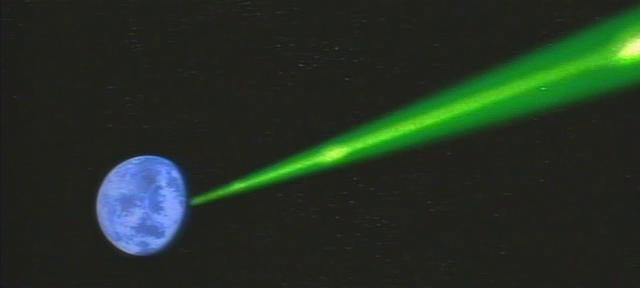
Frame 0
Just before the superlaser makes contact. Note well the white (or, more correctly, brighter blue) cloud pattern which the superlaser beam is about to make contact with.
I presume you are referring to the fact that the "halo" in frame 1 and 2 will skip across those clouds, which obviously indicates an irregular propagation pattern. This might be indicative of a shield/cloud interaction of some kind. So what?
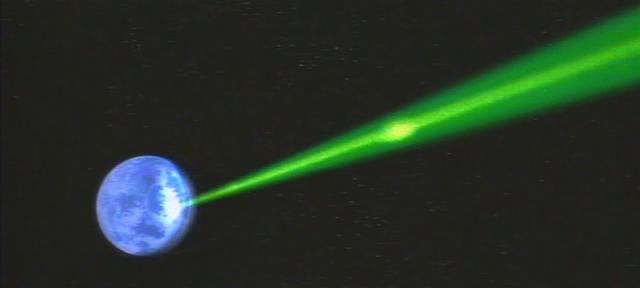
Frame 1
I neglect to mention a halo effect outside the atmosphere because there is no evidence for it being outside the atmosphere. If one assumes that all planets are approximately spherical, one might notice that Alderaan does not appear to be spherical in your Cap 0. That is because we are seeing part of Alderaan's night side on the right side of the planet, past the terminator. To illuminate this point, I have drawn a circle over Alderaan, using part of your AlderaanBlast-1.jpg screen capture.
http://ocean.otr.usm.edu/~randers2/AlderaanBlast-1rsa1.JPG
The circle is 103 pixels tall, and 103 pixels wide. You'll note that the entire planet, plus your halo effect, are contained within the circle, with room to spare.
Contrary to your interpretation, I see no reason to assume that the halo is extra-atmospheric. It would appear to be caused by atmospheric scattering from a bright light source (i.e. the superlaser point of impact).
Not quite, Robert. You are obviously assuming that you can disprove the extra-atmospheric nature of the halo by showing that it's not many hundreds of km away from the surface (even though the atmosphere thins to inconsequential densities beyond 100km altitude, so it would only be 1 pixel "wide" at this range, and your red circle is actually extra-atmospheric!). However, its extra-atmospheric nature is known because of its lack of consistency, not its altitude, which would be virtually indistinguishable from the surface. If it's an atmospheric effect, then there is no reason why you would see patches of blue ocean between the impact point and the "halo" to the right. Atmospheric heating from an intense radiation release does not "skip" hundreds of kilometres. It generates a fireball in all directions moving outward from the point of energy release, with no patches or open holes whatsoever. Since we see blue in between regions of illumination, it is obviously NOT simple atmospheric heating (see the accompanying marked-up screenshot, with white lines pointing out areas which have become more luminescent, and red lines pointing out intervening regions of unaffected blue.
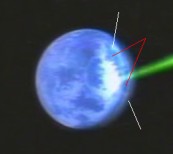
Frame 1 marked-up
Moreover, you have neglected to consider a fairly simple concept known as "line of sight". This principle dictates that atmospheric transmission of light will not occur if there is an opaque obstruction, such as the curvature of a planet. You see, the Earth happens to be round, and this tends to limit the range of direct transmissions, hence the need for communications satellites. It also means that if the beam is heating up a portion of the atmosphere rather than an extra-atmospheric shield , any direct light transmission from the effect will be limited to a radius of 1000-1500km even if it occurs at 100km altitude, where there is little atmosphere to speak of. At 50km altitude (still well outside the useful atmosphere), line of sight is limited to just 800km. But the illuminated areas stretch out for at least 4000km! Therefore, this is obviously not mere light transmission through the atmosphere. The only possible explanations are:
The surface has already been disrupted to such a degree that line of sight has changed. However, the visibility of blue ocean under the intermittent "halo effect" renders this option impossible.
The energy is conducting around the planet in an arcing direction rather than a direct line of sight. Shields can do this, as we saw in TPM. Atmospheres cannot.
There is only one possible explanation for the halo, and that is a planetary energy shield. This is also supported by the ANH novelization, on p.129:
"The defense systems on Alderaan, despite the Senator's protestations to the contrary, were as strong as any in the Empire. I should think that our demonstration was as impressive as it was thorough."
Tarkin bragged that the destruction of Alderaan would be impressive because Alderaan's defense systems were as strong as ANY IN THE EMPIRE (and we know from TESB how easy it is to set up a theatre shield). Think about that; the difficulty of overcoming Alderaan's defense systems was such that he expected THAT feat to impress people, as if simply obliterating an unprotected planet would not be demonstration enough! Moreover, the existence of Alderaan's planetary shield is well-established in the official literature (which you completely ignore, of course).
Indeed, this constitutes a severe problem for your Direct Energy Transfer (DET) theory.
Without any evidence for a planetary shield, one must assume that the planet was laid bare for the superlaser hit. If that is so, then an energy beam with your calculated energy of 1e38J should have produced severe atmospheric disruption, including but not limited to cloud burn-off, profound ionization effects, and so on.
"No evidence for a planetary shield?" I am surprised to see you resorting to blatant falsehoods so quickly.
Planetary shield technology is known to exist (from TESB and ROTJ).
Visible "halo effect" which extends far beyond line-of-sight from the impact point and which passes over underlying unaffected oceans, thus indicating extra-atmospheric, arcing movement.
Tarkin obviously thought Alderaan was heavily defended (from the canon ANH novelization).
We know their sensor technology can detect shield status (from TESB and ROTJ), so Tarkin had no reason to go on assumptions; he could simply scan the planet and see whether its defenses were operational, so his assessment of Alderaan's defenses was most likely based on direct observation.
Alderaan's military people had plenty of time to spot the Death Star approaching and raise a shield if they had one
None of this is news to you; it has been mentioned before, by other people in other places. You are committing the "appeal to ignorance" fallacy, in which you claim that because we cannot absolutely prove the existence of Alderaan's shield, it must not exist. The fact that the existence of a shield is the most reasonable explanation for the evidence at hand seems to escape you. Moreover, you are generating a false dilemma. You ask us to choose between DET/no shield and MCR/no shield, when the third option of DET/shield (ie- the conventional theory) is perfectly viable.
In a prior calculation, I have estimated the energy density per unit volume of a 5 kilometer diameter superlaser beam traveling through the troposphere.
The troposphere is the lower 12 kilometers of atmosphere (the rough limit of cloud-tops on Earth, because the stratosphere above is far drier). Assuming that a mere 3.5e24J of energy (about 1/28,570,000,000,000th, or 1/28-trillionth, of your 1e38J figure) would be absorbed evenly throughout that volume of atmosphere (235.6km^3), we have an energy density per volume of 14.6e12J/m^3.
That's almost 3.5 kilotons of TNT per cubic meter of Earth-like tropospheric atmosphere. Given that the density at sea level is about four times what it is at the top of the troposphere, it would be a "mere" .9 kilotons or so per cubic meter at the likely height of the thick Alderaan cloud-tops.
Some . . . and now, evidently, yourself included . . . have argued that a planetary shield is the explanation. In a way, you are correct . . . it is the only explanation that can possibly explain the situation.
So you admit that the conventional explanation works, which means that it's a perfectly viable theory. Concession accepted.
Since the conventional explanation relies ONLY UPON PHENOMENA WHICH ARE KNOWN TO EXIST, and you concede that it works, it is intrinsically superior to any theory which introduces extra phenomena (particularly undefined ones such as your undefined MCR), regardless of whether that alternate explanation also works (which it cannot in your case, since your MCR is undefined and therefore has no predictive capabilities). See Occam's Razor.
However, the attempted explanation does not work in light of the canon facts. When the Death Star II fired on and destroyed Rebel starships, the hulls of those vessels did not show the sort of bright-white illumination Alderaan shows until actual impact of the superlaser against the ships' hulls occurred.
<snip examples>
"Weak analogy" fallacy: You assume that since A and B perform similar functions, then ANY property of A must also apply to B. To be more specific, you assume that since a planetary shield and a starship shield are both shields, then ALL of their outward characteristics must be identical. This fallacy ignores the fact that there are many underlying differences between A and B (eg- sheer scale, the fact that one operates in or near an upper atmosphere while the other doesn't, the fact that one is projected thousands of kilometres away from its base while the other is a "hull-hugger", etc), so not all properties of A are guaranteed to apply to B.
A real-life example of this fallacy would be to assume that since a rear-projection TV and a CRT TV are both TV's, and CRT TV's are known to employ powerful magnetic fields, rear-projection TV's must employ powerful magnetic fields too. Therefore, if we were to use your "reasoning", we could prove that a rear-projection TV is not a TV by simply observing the absence of the strong magnetic field.
Please try to avoid this kind of broken logic in future. You have proven quite nicely that the Alderaan planetary shield is not 100% identical in every respect to a Rebel starship shield (a trivial proof, since there are so many known differences already). However, you have NOT proven that the Alderaan planetary shield did not EXIST.
Translate back to Alderaan, and the extreme brightness at the targeted area can only be explained as a direct hit to the solid surface. Since no atmospheric effects are observed, we must assume that the atmospherically-absorbed DET was far, far, far less than 3.5e24J, 1/28-trillionth of the 1e38J figure.
<snip calcs based on energy release at 12km altitude and below>
You are claiming that a direct hit to the SURFACE would create atmospheric luminescence which skips across the clouds and ignores everything else, including the oceans which happen to be on that surface? And how would it do this, particularly with your 12km altitude, at which the line of sight is less than 400km? We all know that it looks like this because the Lucasfilm special-effects people digitally brightened the cloud patterns rather than drawing an explosion (ie- they were deliberately delaying the explosion), but even if we stick to suspension of disbelief and ignore such off-screen facts, you still must deal with such issues as line of sight, the established nature of radiation/atmospheric interactions, etc.
You present this bizarre and physically nonsensical theory as a superior alternative to the conventional explanation (whose viability you have already CONCEDED) based solely on your INSISTENCE that there is no shield. In short, you admit that your theory is not intrinsically superior to the conventional theory, so your theory is worthless unless you can prove that Alderaan has no planetary shield despite the escalating political tensions, the Empire's increasing belligerence, the fact that the technology is known to exist, Tarkin's quote, etc.
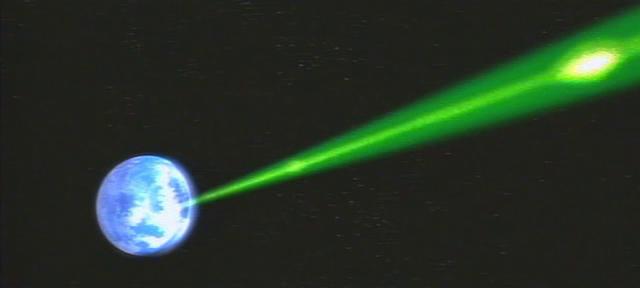
Frame 2
<snip> The halo effect is probably a visible
manifestation of the planetary shield's reradiation mechanism.
Or simple atmospheric refraction of such incredible brightness occurring at a point on or near the surface where the superlaser hits. Note that we can now see a continuation of the cloud pattern where the superlaser hits, extending past the terminator to the lower right. However, note also that the ground below is still semi-shaded, in keeping with the terminator. This also suggests a simple atmospheric effect, since a point-source of extreme brightness at or very near the surface would directly light up the distant clouds, but could not be expected to directly light the planet's surface over the horizon from the point-source.
Wrong. The physics of high-energy atmospheric interactions are well-known after decades of research on nuclear weapons, plasma, interactions of radiation with atmosphere, etc. They propagate outward in all directions. They do NOT skip across clouds and ignore material in-between, nor do they ignore line-of-sight.
Incorrect. I do not make that comment in reference to the frame (Frame 2) you have provided. Instead, your quote applies to the fourth frame. http://ocean.otr.usm.edu/~randers2/STSWdeathstar2.html
Correction noted. I was unable to verify the correct captions because of a 403 (permission denied) error that appeared on the relevant page on your site last week and disappeared after I uploaded my post (too much to be a coincidence; I imagine you denied access to the file deliberately). This also applies to your OTHER red-herring nitpicks about me not matching your captions to the correct frame number later on in this post, so I will refrain from repeating myself and simply skip those in my reply.
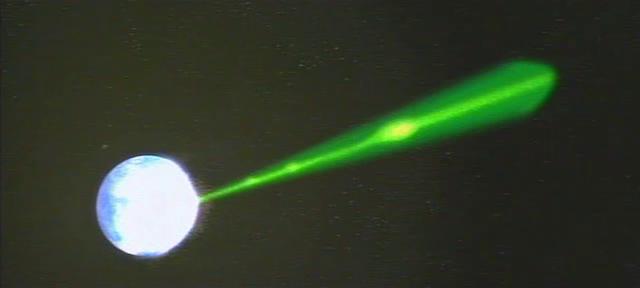
Frame 3
Dramatic intensification of halo effect, which is now
so bright that it saturates the video medium.
Unfortunately, there is no shield halo effect in play. However, the video medium is saturated . . . to the point that even the space around the planet exhibits an increase in brightness of several planetary diameters. The "Superlaser Effect"-proper has now begun in earnest. In the next frame, we will see a more orange color, a characteristic of fire. Hence my comment about a firey explosion. The saturation of the medium will also reduce somewhat, manifesting as a temporarily-lessened 'glow' of the empty space around Alderaan.
Red herring fallacy. Unless you can show HOW AND WHY these phenomena make the conventional explanation unworkable (and you have already conceded that you can't, unless you remove the shield from the equation), they are not important. The only other possible reason to mention them (apart from the "smokescreen of superfluous detail") is if they are consistent with the predictions generated from your undefined MCR theory. Unfortunately, since your undefined theory makes no concrete predictions, this is impossible. Please review basic scientific method.
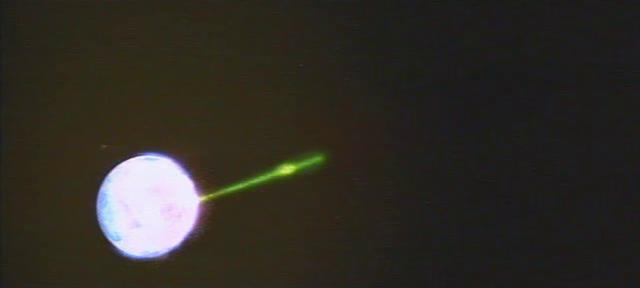
Frame 4
Slight change in the halo effect's physical
appearance, although the coverage area has not dramatically changed
(note that the far side is still blue).
Quite correct. Not only does the left side of the planet remain visibly unaffected (besides a possible brightness increase in the area) as I have made reference to previously, but the polar regions also do not appear to have disassembled at all.
The conventional theory explains it via the simple fact that there hasn't been enough time for a core or mantle expansion to breach the surface. Explain how your undefined MCR predicts this, particularly since you claim that your MCR propagates along the SURFACE layers.
This would imply that the superlaser is drilling into the planet's mass already, although the sheer scale means that there will be a measurable time lag before the surface expands (even at 5% of c, it would take 1 frame for a lower mantle expansion to breach the surface and 5 frames for a core expansion to breach the surface). Intensification without forward progress is consistent with a shield, but not with your mysterious surface-level chain reaction.
I disagree. Besides the fact that there is no evidence for a shield, there is also the problem for DET wherein shield failure should not provide for the exact same area to be affected as observed.
Scientific ignorance: by assuming that the superlaser must start from zero at the moment it breaches the shield, you neglect conservation of energy. You see, there is a principle in basic physics which tells us that the total amount of mass/energy in a closed system must remain constant. Some like to phrase it as "mass/energy cannot be created or destroyed". This principle is also known as the First Law of Thermodynamics. In this case, the conventional theory calls for the superlaser to have deposited an enormous amount of energy into the shield, which could not re-radiate this energy at anywhere near the necessary rates. In other words, the shield is accumulating energy, hence its failure. But when the shield fails, the accumulated energy MUST GO SOMEWHERE, hence it hits the surface of the planet over an area roughly equal to the halo. Do you believe it simply vanishes without a trace?
If a shield had failed, and if the superlaser is indeed "drilling into the planet's mass already" using DET, the expansion perils you mention can only apply to DET, alone. Why? Because the beam must be depositing its energy into a relatively small patch of planet, drilling its way down. Disastrous surface and atmospheric effects would be expected, of course, but the expansion you speak of is only necessary at this time with DET. Meanwhile, the Superlaser Effect theory does not require core or inner/lower mantle effects or visible ejecta from those regions at this point. The crust, upper mantle, and mantle (a.k.a. transition region, down to 650km) are sufficient. Even if one were to argue that we needed to see parts of the mantle as visible ejecta, then at your suggested 5% lightspeed, this would be just barely over a frame at 24fps.
Slothful induction fallacy. I provided numbers to show that a core or mantle expansion would take between 1 and 5 frames to breach the surface even at 5% of c, thus explaining why the planet is not yet expanding without having to resort to undefined theories. Your retort that conventional physics cannot explain the lack of "expansion perils" completely misses the point.
Note also that the approximate point of superlaser impact is now a much darker region. I believe this represents the coalescence of the band which will shortly begin to encircle the globe.
Show how your undefined MCR predicts a dark spot which is up and to the left of the superlaser impact point (see screenshot below). Show how your undefined MCR predicts these imaginary bands of yours. Show how your undefined MCR predicts the "coalescence" of these imaginary "bands". Show how your MCR predicts a dark spot mysteriously turning into a destructive "band".
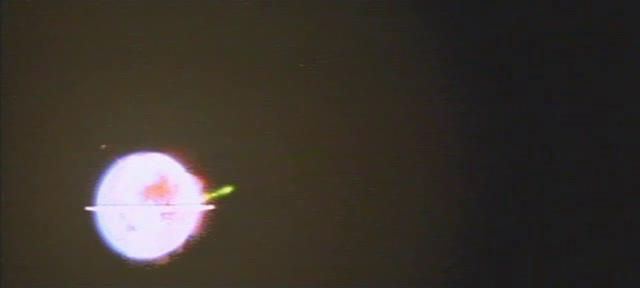
Frame 5
Blank: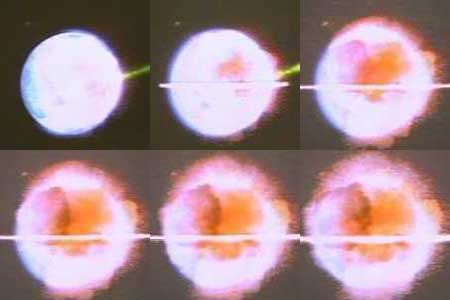
http://ocean.otr.usm.edu/~randers2/RSAband.jpg
Marked: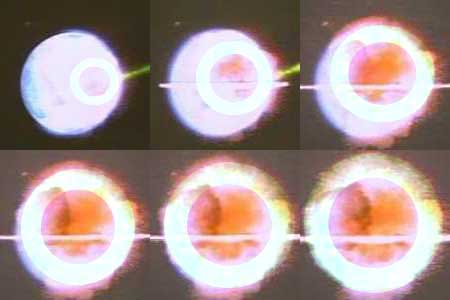
http://ocean.otr.usm.edu/~randers2/RSAband1.jpg
In the above two links, I have attempted, in spite of my utter lack of artistry, to roughly illustrate what I refer to as the globe-encircling band. It is easier to see if you advance the video at about one frame per second, but the bright band is there in any case. As you continue to look at the frames, pay attention to the fact that the surface remains substantially intact until the band passes.
The bands are a figment of your imagination. Nothing more. No one sees these glowing "bands" but you. You simply drew a circle around the reddish portion of the explosion and called it a "band", even though the white-hot portion of the planet is already a full hemisphere in the very first frame! Worse yet, you make the audacious claim that the surface remains "substantially intact" until the band passes, even though everyone in the world can see that in the first frame, the surface has already been vapourized into WHITE-HOT GAS over the ENTIRE HEMISPHERE! Do you seriously expect anyone to agree that the surface is still "substantially intact" ahead of your imaginary "band" even though it's already glowing like the Sun? Thank you for finally showing exactly where you imagine these "bands" to be, and in so doing, proving that A) they do not exist, and B) your theory that the destruction lags behind them is clearly wrong.
No, not "completely unaffected" . . . just "stable". In other words, it isn't currently in the process of blowing to smithereens (though I can't imagine the stable surface areas were having a field day at this point). In any case, the surface appears to be holding. However, the area is significantly brighter than it previously was.
<snip>
As you can see, the same atmospheric brightening on the left is in play here, as is in play in your superimposing of Frame Five. Understandably, it is not to the same extent, but the white sliver of the effect is there.
So you admit that it is "not to the same extent", ie- that the glowing area is noticeably larger in frame 5 than it is in frame 2. As we can clearly see by comparing your overlay and mine (below), there is already glowing material several pixels (ie- several hundred kilometres at this magnification) away from the far sideof the planet by frame5, whereas there was nothing but a mild halo in frame 2. Concession accepted.

Your
Frame2 overlay and my Frame5 overlay
You'll note that according to your argument, Frame Two represents a frame in which a shield is up. However, applying your Frame Five argument to Frame Two must also suggest that "the planet has already been heated to such an extent" that material, mysteriously glowing blue, is being hurled away from the left side of the planet, in spite of the shield, and in spite of the fact that all ejecta observed thus far is orange. I submit that what we are seeing is atmosphere in both cases, especially given that the surface appears stable (i.e. blowing to smithereens not in progress).
Wrong. As everyone can see by looking at the screenshots, the glow is marginally distinguishable from the edge of the planet in frame2 but it has expanded by several hundred kilometres in frame5, PRECISELY as we would expect for the far side of a shield which has just been struck by a superlaser versus a shield which has already collapsed. The conventional theory is unaffected by your attempts to misrepresent the evidence. As for your belief that we are seeing "atmosphere", you seem to be implying that there is usably dense atmosphere up to an altitude of several hundred kilometres, and that it would be heated to luminescence by an undefined MCR which has not yet reached it, and which does not even have a clear line of sight (according to your own "band" drawings).
<snip>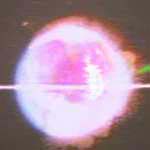
http://ocean.otr.usm.edu/~randers2/AlderaanBlast-6&1rsa.jpg
The above is a partial superimposing of Frame Six, the frame in question, and Frame One, the first frame to show the superlaser hitting the planet. You'll note that the cloud formation which the superlaser struck the central lower half of is positioned at the lower right of the reddish-orange area. Given the location and the curvature on the planetary sphere, some of the reddish-orange area further toward the right may be brightened by the band beyond (i.e. further to the right), as compared to the material we get to see dead-on. In any case, what little deviation there may be does not significantly affect the findings.
"Little deviation"? Your own overlay shows that the centre of the dark spot is at least 3500 KILOMETRES away from the impact point (and more if you account for the third dimension). I don't see how you can claim to conduct a "rational, evidence-based debate" when you explicitly deny that which can be easily seen by all.
[Quoted] All I see is a planet which is rapidly expanding, albeit with a slight asymmetry that is easily explained by energy propagation delay through the planet's mass.
Why should there be an asymmetry of this type? I do not see how propagation delay would explain an explosion/expansion which, by your own statements, is leaning a little to the left of the superlaser impact point.
Wrong. At THIS point in the explosion (frame5), the asymmetry is clearly skewed to the RIGHT, hence my comment. However, as the explosion progresses, much of the cooler bulk will be pushed to the left by the asymmetrical plasma ejection on the right-hand side.
Again, you seem to be inventing observations out of thin air. The dark patch is now well to the left,
Which, given that it is the material we are seeing dead-on, makes sense.
Wrong. The superlaser impact point is well over to the right side of the planet, so ejecta from the point of impact SHOULD be moving to the right, not directly toward us. The dark patch is NOT centred around the superlaser impact point.
<snip>
Note: I disagree with the placement of Frame 27 as the beginning of the secondary explosion. The first visible sign should occur at Frame 23, assuming your present version and the DeathStar-SE.avi from your page are paced the same.
Red-herring nitpick.
Further, in the process of watching DeathStar-SE.avi frame-by-frame in that section to determine the proper start point, I have noticed something very unexpected and very unusual which no one else seems to have noticed before. In fact, it is so unexpected and unusual that I may need to revise the admittedly-limited theoretical background of the Superlaser Effect theory to account for it.
You have a "theoretical background" for your undefined MCR? Please, by all means, share it with us.

http://ocean.otr.usm.edu/~randers2/DeathStar-SE-Polar.jpg
<snip>
Make note, if you will, that "Santa survives", at least temporarily. There is a planetary surface remaining in the polar region at least until shortly before the secondary explosion. The last frame, 93, is a frame or two before your screencap Frame 27 above.
In the frame marked 68, we see the northern polar region just as the superlaser is striking near the equator. In 72, we see the pole partially obscured by the band which is approaching it. In 77, the band is over the polar region, the surface of which is partially obscured by the dark funk over on the left, and quite obscured by the bright band. In 82 you get to see how the band finally becomes obscured by the polar surface as it rounds the pole.
The polar surface is still visible in 87, albeit even more obscured by funk. In 91, a firey cloud begins to obscure the polar surface on the right, just as the funk obscures it on th eleft, but it is still visible even into the frame marked 93.
Not possible. By frame 5, the polar regions have ALREADY expanded beyond the atmosphere. You are taking chaotic, debris-filled screenshots and using them to "disprove" a conclusion drawn from a relatively clean, clear screenshot. You have a hazy, greyish area and you assume it must be a solid "polar surface"? Does it occur to you that this might be a mere insubstantial planet-shaped haze, like the one that's left over at the END of the explosion? See the accompanying screenshot:
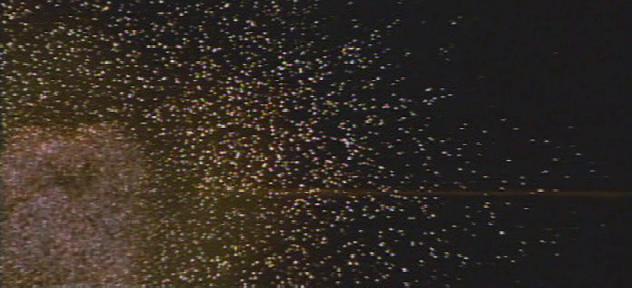
Last
frame before scene-break
Even when there's nothing left but a hazy cloud, you could still very easily point to a spot on the periphery of the cloud and (if it's sufficiently obscured) pretend that it represents solid surface. You are using the chaos of the explosion to misrepresent vague shapes as an intact, solid planetary surface.
I confess to being excited. I thought I'd seen everything there was to see in the clip, but here's new information all of the sudden, yet another piece of data about Alderaan's destruction that no one else has noticed. "Vision problem", my butt.
Your state of excitement is of no interest to me or anyone else. A brief period of inertial confinement might tend to sustain a dense mass at the centre of the explosion for some time; this is well known from ICF experiments. However, your bizarre leap in logic (that the appearance of any persistent shape, glow, or mass in the planet's location must represent the original intact, solid surface of the planet still in place) is simply absurd; the sheer velocity of ejecta from the planet precludes any possibility of an intact surface.
In regards to DET arguments, several revisions would seem to be in order. Most notably, the claim that the band is merely the entire planet glowing and expanding, "white-hot matter shooting into space", makes no sense. I think all DET theorists are left with as an option to explain the bands is total atmosphere burn-off, but since the superlaser couldn't have deposited more than 23.5 gigatons of energy into the atmosphere as mentioned previously, it sounds like you need an energy increase to begin at the surface upon superlaser impact. Sort of a "superlaser effect", if you will.
Your 23.5 gigaton figure is dependent upon your claim that there's no shield. You cannot use this to disprove the validity of the conventional theory which DOES include a shield. This is sophistry of the highest order; even if there is only the POSSIBILITY of a shield, that's more than enough to evaluate the DET/shield theory as-is, rather than forcibly stripping away the shield component as if it has been proven impossible.
By the way, please refrain from the use of prejudicial language such as "DET theorists", which makes it appear as if the application of conventional thermodynamic heat transfer physics is a peculiar doctrine, and/or that those who subscribe to it are some kind of monolithic group. This is not the case, and if you sincerely wanted a rational argument, you should avoid using these kinds of prejudicial characterizations (it is analogous to the way creationists label anyone who accepts mainstream science as "evolutionists").
Also, with the left side and now the polar surfaces remaining visibly intact for so long after the termination of the beam, I think it very difficult for DET theorists to maintain their argument. After all, the superlaser beam actually did very little when it struck the planet . . . but it is readily apparent that something else happened afterward.
Yet again, I must point out that the sides and polar surfaces are NOT intact. They were very clearly blown past the atmosphere by frame 5. I will not humour this repetitive argument technique of yours again. As for the termination of the beam, you are assuming that the visible portion of the beam is the entire beam. TESB proved that this is not the case, and the SW2ICS clearly indicates that the visible pulse is a mere carrier on the underlying invisible beam. Therefore, your assumption is known to be false, as are all conclusions derived from that assumption.
Of course, any DET theory at this point, as before, is an exercise in ad hoc rationalizations.
If a rationalization works, it does not matter whether it is "ad hoc" or not. The source of an idea does not have any bearing on the validity of that idea. Please review basic scientific method and elementary logic. Unless, of course, that statement was mere grandstanding, in which case you should be mindful of your OWN request for a strictly rational debate.
For the Superlaser Effect theory, the new facts will require some sort of revision of some of my earlier hypotheses, which were based on the previously available data.
For the second time, please define this superlaser effect, and describe the physical processes it induces in the target. You have repeatedly referenced a hypothesis, but you have yet to provide anything more than its name.
I'm not quite sure what to make of things . . . there may be a similarity with DSCalamari.mpg frames 228 and 229:
<snip>
...where the superlaser hits the Wingless and, though the ship's outline is still visible in the frame, it is absolutely engulfed with a quick, gassy-looking puff that expands and dissipates rapidly, while the ship's actual exploding process occurs in a much smaller area.
Correct. This is analogous to the shield collapse effect at Alderaan, where a thin surface layer is superheated and blown off by energy released when the shield collapses. Thank you for providing a useful correlation between the Alderaan shield and the Rebel shield (although I'm not sure how it's supposed to support your undefined MCR theory).
(Also, I had already planned to point out the possible connection between the secondary blast of Alderaan and the secondary blast which finally wiped out the Liberty after her long, slow primary explosion. Frames 127 and 128 of the DSCalamari clip show the immediately before and immediately after the secondary blast:<snip>
Yes, the Liberty experiences a non-linear explosion. Explain how your undefined MCR theory predicts this.
In short, the main problem would seem to be that the bands are not as destructive as I thought. With the surface obscured and the debris flying every-which-way, it wasn't too much to conclude that the surface of the planet was so much debris, with that matter being converted into the energy source for the bands. But, this may be contrary to that. Alternately, they're just as destructive as I thought, the "surface" that is still visible is merely mantle of some sort, with the upper layers having been consumed. I'll have to go back and look at some of the alternatives I had previously considered but discarded due to insufficient data. Anyway, there's still enough to go on at the moment to deal with the rest of your claims, so . . .
You can wax poetic about all the possibilities opened up by your undefined MCR (and those possibilities are infinite, hence the great convenience of an undefined theory), but as it is still undefined, it DOES NOT EXIST as a viable theory. Period. Define this theory. Explain exactly HOW it can accurately predict all of the phenomena you insist on describing as de facto disproof of the conventional explanation.
It would be a gross understatement to say that the fire rings are a curious phenomenon.
Yes, and they are impossible phenomena for DET to explain. <snip several theories and related attacks on those theories>. Also, just as a general concept, note the fact that the DET-Alderaan theory has absolutely nothing to offer in regards to the Death Star rings. It is yet another weakness of the DET theory. <snip>
Alternative syllogism fallacy (A or B; if not A, then B). The fact that the conventional explanation cannot explain the non-physical behaviour of the fire rings does not lend weight to your undefined MCR. If it does not lend weight to your undefined MCR, it does not weaken the conventional explanation, since one can only topple a theory by providing a better one, not by showing that the existing one is imperfect and expecting your undefined alternate to win by default (note that this might be classified as a false dilemma fallacy instead, depending on how your MCR is defined).
And where is this debris heading TOWARD the Death Star that you describe?
They . . . or, more properly, the first one . . . appears in frame 103 of DeathStar-SE.avi, which should translate into frame 35 of your variant. I'm referring to those bigger dark masses of material. Several are visible both above and below the ring seven frames later, hence my use of the term "general direction".
Example:
http://ocean.otr.usm.edu/~randers2/blind.jpg
<snip pointless repetition of earlier arguments>
Interesting. And you conclude that these chunks of debris support your undefined MCR, eh? What makes you think they are remarkably large, or represent a significant variation in explosion mechanics? What makes you think that equally large pieces are not flying in OTHER directions, eg- away from the camera? Have you ever heard of a concept known as "perspective correction?" It has to do with the fact that objects which are closer to you tend to appear larger, and it is a function of simple trigonometry: the subtended angle of an object is a function of the ratio of its width to its distance from you. I suggest you consider this concept before making any more bold statements on significant fractions of the planet's mass heading toward the Death Star.
your "observation" turns out to be a fabrication, along with any conclusions reliant upon it.
It is taking a bit of effort to maintain self-restraint against such petty attacks, but not a great amount. Self-control: use it.
An attack upon your arguments and claims is hardly a "petty attack"; on the contrary, it is PRECISELY what a rational debate is for. Do not attempt to overplay your well-worn "victim" card. Logic: use it.
I have not misrepresented the evidence, and the only "extremely poor-quality copy" of it that I have is the one I downloaded from your site, and which you earlier admitted to creating <snip more boasting about your victory, not to mention some gratuitous prejudicial grandstanding about how me and my "associates" will now be "revising claims about the evidence">.
It serves no logical purpose to tell people that you believe you are decisively winning. The audience can judge the truth or falsehood of that for themselves.
You may also wish to prepare yourself for the attack on DET from the Principle of Parsimony. I do not know what valid defense can be employed by DET theorists, but I'll be curious to see what is attempted.
The principle of parsimony is intrinsically hostile to any theory which introduces extra or undefined mechanisms. Therefore, any attack made by you against this station would be a useless gesture.
Summary
In the end, the logical failings of your argument (as opposed to its dubious factual claims such as the "bands" which nobody else can see even after you showed us your marked-up images) fall into two broad categories: strawman and alternative syllogism.
100% of your arguments against the conventional theory are strawman distortions, because the conventional explanation includes a shield, and you insist on REMOVING the shield from that theory before attacking it. You would no doubt retort that there is no evidence for the shield, but you seem to have forgotten the definition of scientific evidence: by your own admission, the visible characteristics of the initial impact can be explained with a shield. THAT IS EVIDENCE OF THE SHIELD'S EXISTENCE! Please review basic scientific method. You fail to recognize that even the POSSIBILITY of a shield is enough to allow its use in a theory.
100% of your attempts to generate evidence for your undefined MCR are examples of the alternative syllogism fallacy (if not A, then B). You assume that if you can damage the credibility of the conventional explanation in any way, this automatically supports YOUR undefined MCR. This is completely irrational; it is possible for A to have weaknesses without B necessarily being stronger than A. The ultimate explanation may be only a small variation upon A; there is no logical reason to assume that if A is shown to be less than perfect, B wins by default. Your "evidence" is invariably an attempt to undermine the conventional explanation without even TRYING to define your theory or explain how it predicts the minutely detailed (and often questionable) observations you describe.
Please refrain from such strawman attacks and alternative syllogism fallacies in your next post (and yes, I recognize that this would cut down your post to nothing; you'll have to think of something new). I thought you said you wanted a rational debate.
